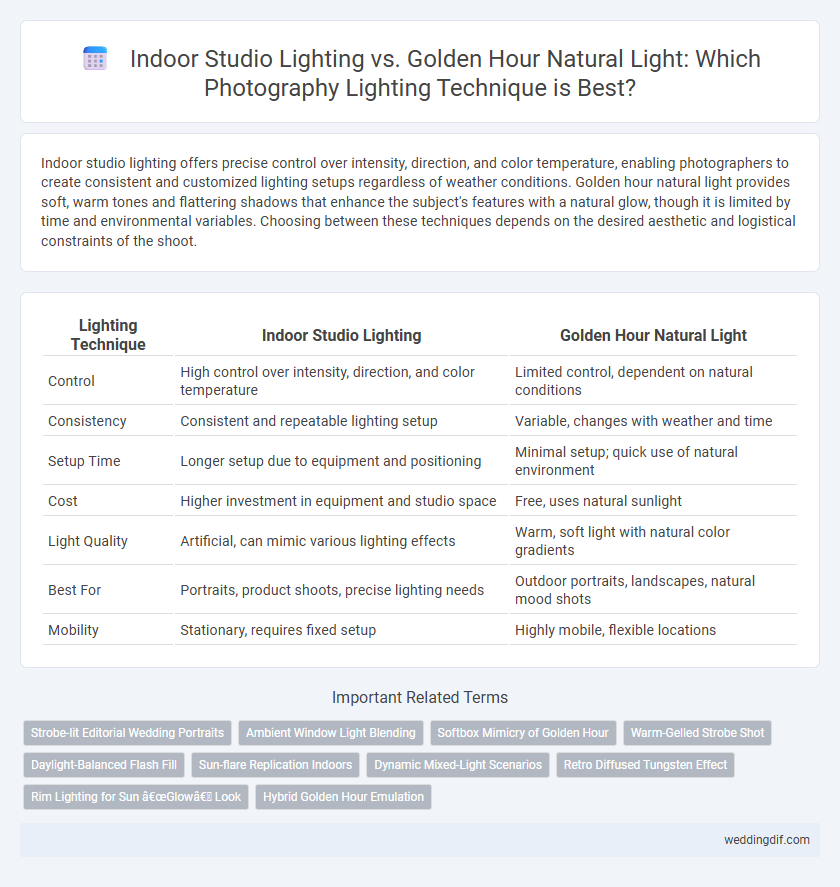Indoor studio lighting offers precise control over intensity, direction, and color temperature, enabling photographers to create consistent and customized lighting setups regardless of weather conditions. Golden hour natural light provides soft, warm tones and flattering shadows that enhance the subject's features with a natural glow, though it is limited by time and environmental variables. Choosing between these techniques depends on the desired aesthetic and logistical constraints of the shoot.
Table of Comparison
| Lighting Technique | Indoor Studio Lighting | Golden Hour Natural Light |
|---|---|---|
| Control | High control over intensity, direction, and color temperature | Limited control, dependent on natural conditions |
| Consistency | Consistent and repeatable lighting setup | Variable, changes with weather and time |
| Setup Time | Longer setup due to equipment and positioning | Minimal setup; quick use of natural environment |
| Cost | Higher investment in equipment and studio space | Free, uses natural sunlight |
| Light Quality | Artificial, can mimic various lighting effects | Warm, soft light with natural color gradients |
| Best For | Portraits, product shoots, precise lighting needs | Outdoor portraits, landscapes, natural mood shots |
| Mobility | Stationary, requires fixed setup | Highly mobile, flexible locations |
Understanding Indoor Studio Lighting Techniques
Indoor studio lighting techniques offer precise control over light intensity, direction, and color temperature, enabling photographers to create consistent and customizable lighting conditions regardless of time or weather. Equipment such as softboxes, umbrellas, and LED panels facilitate manipulating shadows and highlights to enhance subject features and mood. Mastery of these tools ensures sharp images with balanced exposure, critical for portrait and product photography.
Exploring Golden Hour Natural Lighting Essentials
Golden hour natural lighting offers warm, soft tones that enhance skin textures and create a dreamy atmosphere, making it ideal for portrait and landscape photography. Unlike indoor studio lighting, it relies on the sun's position, producing dynamic shadows and highlights without artificial modification. Understanding the timing and angle of golden hour light is essential to maximize its potential and capture compelling images with natural vibrancy.
Key Equipment Needed for Indoor Studio Shoots
Indoor studio lighting requires key equipment such as continuous LED panels, softboxes, and adjustable light stands to control light intensity and direction precisely. External flash units with modifiers like umbrellas or beauty dishes help create soft, evenly distributed light, mimicking natural conditions on demand. Light meters and backdrop supports further enhance the setup, allowing photographers to achieve professional-quality images regardless of ambient light limitations.
Benefits of Using Golden Hour for Wedding Photography
Golden hour natural light offers warm, soft, and flattering tones that enhance skin textures and create romantic atmospheres, ideal for wedding photography. Unlike indoor studio lighting, golden hour provides dynamic, natural shadows and highlights that add depth and authenticity to portraits. Utilizing this natural lighting minimizes the need for extensive artificial setups, allowing for spontaneous and visually captivating shots.
Common Challenges in Studio Lighting Setups
Indoor studio lighting setups often face challenges such as harsh shadows, uneven light distribution, and color temperature inconsistencies that can affect image quality. Precise control over power settings, light modifiers, and positioning is essential to avoid flat or overly dramatic effects. Managing reflections and achieving a natural skin tone remain key obstacles compared to the softer, more diffused qualities of golden hour natural light.
Overcoming Limitations of Natural Golden Hour Light
Indoor studio lighting provides precise control over light intensity, color temperature, and direction, overcoming the brief duration and variability of golden hour natural light. Artificial lights enable consistent shooting conditions regardless of weather or time, which is essential for achieving uniform exposure and color balance in professional photography. Using modifiers like softboxes and reflectors enhances the quality of artificial light, mimicking the softness and warmth characteristic of golden hour while retaining full creative control.
Color Temperature Differences: Studio vs Golden Hour
Indoor studio lighting typically offers a controlled color temperature ranging from 3200K to 5600K, enabling photographers to maintain consistent white balance and color accuracy. Golden hour natural light, with its warm, low-angle sunlight, generally falls between 2000K and 3000K, creating rich orange and red hues that enhance skin tones and add a dramatic ambiance. Understanding these color temperature differences helps photographers choose the best lighting technique to achieve desired mood and color rendition in their images.
Achieving Mood and Atmosphere in Wedding Photos
Indoor studio lighting offers precise control over light intensity, direction, and color temperature, allowing photographers to craft dramatic or soft moods tailored to each wedding scene. Golden hour natural light provides warm, diffused illumination with rich, golden tones that naturally enhance romantic and intimate atmospheres in wedding photos. Balancing these techniques enables capturing both meticulously styled shots and authentic moments, optimizing mood and atmosphere for diverse wedding narratives.
Post-Processing Tips for Each Lighting Technique
Indoor studio lighting allows precise control over shadows and highlights, enabling cleaner, more consistent exposure that simplifies post-processing. When editing studio images, focus on fine-tuning contrast, white balance, and sharpness to enhance the crispness of artificial light. For golden hour natural light, prioritize warm color correction and gentle noise reduction to preserve the soft, diffused glow while maintaining natural skin tones during post-processing.
Choosing the Right Lighting Method for Your Wedding Style
Indoor studio lighting offers precise control over intensity, direction, and color temperature, making it ideal for achieving consistent and dramatic effects in wedding photography. Golden hour natural light provides a warm, soft glow that enhances romantic and candid moments with natural ambiance. Selecting the right lighting method depends on your wedding style's mood, from the polished look of studio setups to the organic beauty captured during golden hour.
Indoor Studio Lighting vs Golden Hour Natural Light for lighting technique. Infographic

 weddingdif.com
weddingdif.com